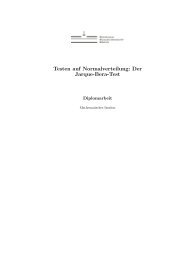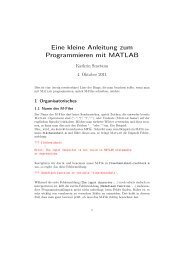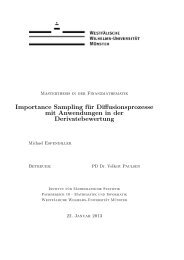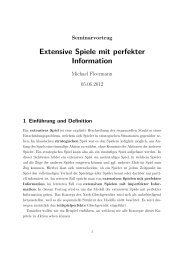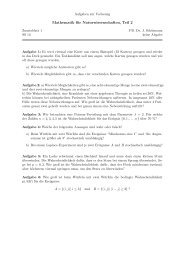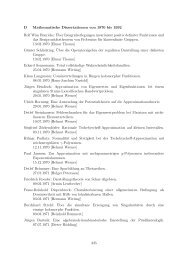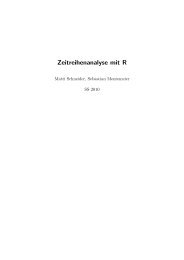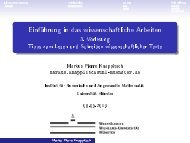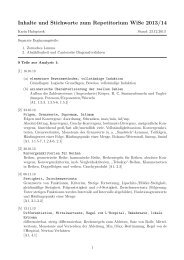Margulis Lemma
Margulis Lemma
Margulis Lemma
Create successful ePaper yourself
Turn your PDF publications into a flip-book with our unique Google optimized e-Paper software.
28 VITALI KAPOVITCH AND BURKHARD WILKING<br />
We first consider the induced diffeomorphisms ¯f i : M i → M i which converge to an<br />
isometry ¯f ∞ of R k × K. Thus, there is A ∈ O(k) and v ∈ R k such that the induced<br />
isometry of the Euclidean factor pr( ¯f ∞ ): R k → R k is given by (w ↦→ Aw + v).<br />
We claim that we can assume without loss of generality that v = 0. In fact,<br />
by Proposition 3.8, we can find a sequence of diffeomorphisms g i : M i → M i with<br />
the zooming in property such that g i converges to an isometry g ∞ which induces<br />
translation by −v on the Euclidean factor. Moreover, there is a lift ˜g i : ˜Mi → ˜M i<br />
which also has the zooming in property if we endow ˜M i with the base point ˜p i . By<br />
<strong>Lemma</strong> 3.4, we are free to replace f i by ˜g i ◦ f i and hence v = 0 without loss of<br />
generality.<br />
Since ¯f ∞ fixes the origin of the Euclidean factor, we obtain that for the limit f ∞<br />
of f i the following property holds. Given any m > 0 we can find g m ∈ G such that<br />
d(f∞(g m m (0, ˜p ∞ )), (0, ˜p ∞ )) ≤ diam(K) in R k × R l × ˜K.<br />
It is now an easy exercise to find a sequence ν b of natural numbers and a sequence<br />
of g b ∈ G for which f ν b<br />
∞ ◦ g b converges to the identity:<br />
We consider a finite ε-dense set {a 1 , . . . , a N } in the ball of radius 1 ε<br />
around<br />
(0, ˜p ∞ ) ∈ R k+l × ˜K. For each integer m choose a g m ∈ G such that<br />
d ( f m ∞(<br />
gm (0, ˜p ∞ ) ) , (0, p ∞ ) ) ≤ diam(K).<br />
The elements (f∞(g m m a 1 ), · · · , f∞(g m m a N )) are contained in B 1/ε+diam(K ′ )(0, ˜p ∞ ).<br />
Thus, there are m 1 ≠ m 2 such that d(f∞ m1 (g m1 a j ), f∞ m2 (g m2 a j )) < ε for j =<br />
1, . . . , N. Consequently, d(f∞<br />
m1−m2 (ga j ), a j ) < ε for j = 1, . . . , N with<br />
g = f∞<br />
m2−m1 gm −1<br />
1<br />
f∞ m1−m2 g m2 ∈ G.<br />
In summary, f∞ m1−m2 ◦ g displaces any point in the ball of radius 1 ε around (0, p ∞)<br />
by at most 4ε. Since ε was arbitrary, this clearly proves our claim.<br />
Let (ν b , g b ) be as above. For each b we choose a large i = i(b) ≥ 2ν b and<br />
g b ∈ π 1 (M i ) such that f ν b<br />
i ◦ g b is in the measured sense close to f ν b<br />
∞ ◦ g b . We also<br />
choose i so large that (f ν b<br />
i(b) ◦ g b) b∈N still has the zooming in property and converges<br />
to the identity. This finishes the proof of Step 2.<br />
Further Notations. We may replace p i with any other point p ∈ B 1/2 (p i ). Thus<br />
we may assume that p ∞ is a regular point in K. Let π 1 (M i , p i , r) = π 1 (M i , p i )(r)<br />
denote the subgroup of π 1 (M, p i ) generated by loops of length ≤ r. Similarly, recall<br />
that G(r) is the group generated by elements which displace (0, ˜p ∞ ) by at most r.<br />
By the Gap <strong>Lemma</strong> (2.4) there is an ε > 0 and ε i → 0 such that π 1 (M i , p i , ε) =<br />
π 1 (M i , p i , ε i ). Moreover, G(r) = G(ε) for all r ∈ (0, 2ε]. We put Γ i := π 1 (M i , p i )<br />
and Γ iε = π 1 (M i , p i , ε).<br />
Step 3. The desired contradiction arises if the index [Γ i : Γ iε ] is bounded by some<br />
constant C for all large i.<br />
If C denotes a bound on the index and d = C!, then (f j i )d leaves the subgroup Γ iε<br />
invariant and we can find a new contradicting sequence for the manifolds ˜M i /Γ iε .<br />
Thus we may assume that Γ i = Γ iε .<br />
As we have observed above, π 1 (M i , p i ) = π 1 (M i , p i , ε i ) for some ε i → 0. We now<br />
choose a sequence λ i → ∞ very slowly such that<br />
• (λ i M i , p i ) → (R k × C p∞ K, o) = (R k′ , 0) with k ′ > k.<br />
• π 1 (λ i M i , p i ) is generated by loops of length ≤ 1.



